I would like to cover some basic techniques for shooting from vehicles. The topic could fill much more space than I have here, so I intend to hit the highlights. We will leave for another day the topic of shooting from moving vehicles and concentrate only on stationary vehicles.
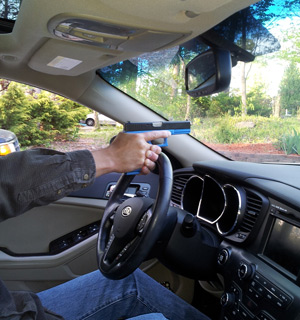 There are several things you should think about before you find yourself confined to the inside of your vehicle when an armed confrontation arises. First, if at all possible, you want to drive away – through/over the perpetrator if you can! Two actions to avoid are ducking for cover inside the prison of your vehicle or trying to back away from your assailant. These tactics will in all probability hasten your demise rather than prevent it. The remaining options, which are the topics of this article, are how to return fire while confined to the interior of the vehicle.
There are several things you should think about before you find yourself confined to the inside of your vehicle when an armed confrontation arises. First, if at all possible, you want to drive away – through/over the perpetrator if you can! Two actions to avoid are ducking for cover inside the prison of your vehicle or trying to back away from your assailant. These tactics will in all probability hasten your demise rather than prevent it. The remaining options, which are the topics of this article, are how to return fire while confined to the interior of the vehicle.
Good people don’t typically have the luxury of determining the time and place of their gunfights. The bad guy usually dictates the terms. All we can do is meet his challenge to the best that our training will allow.
With that in mind … how do we train to engage in a gunfight from inside a vehicle?
Considerations
The first, albeit minor, consideration is to remember that when firing a weapon in a confined area, there is increased overpressure every time a round goes off. This overpressure can potentially be a little rattling but in all likelihood, during the stress of combat, it will be of little significance.
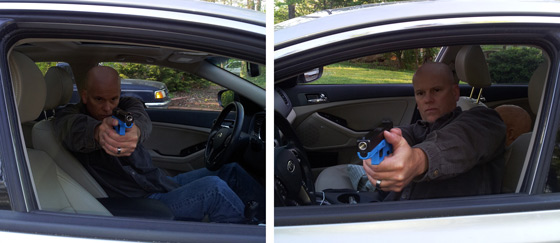 Single occupant, front seat, two-hand, full extension through passenger-side window and driver’s-side window.
Single occupant, front seat, two-hand, full extension through passenger-side window and driver’s-side window.
It is of paramount importance that you practice drawing from your carry rig while inside your vehicle. Try it with and without the seatbelt attached. You never know what issues will arise until you go through them in training.
As is always the case, we like to apply simple, generally accepted principles to any combat situation. When engaging a threat from inside a vehicle, if possible, extend the weapon with both hands toward the threat and start shooting! This may require you to lean into/across the seat.
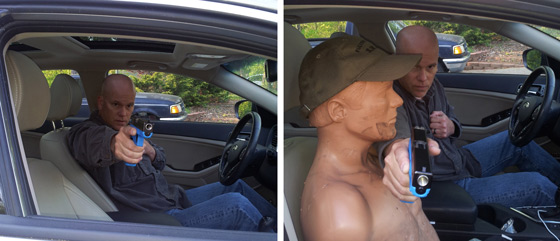 One-handed shooting from driver’s seat out passenger-side window, both without and with a passenger.
One-handed shooting from driver’s seat out passenger-side window, both without and with a passenger.
If circumstances dictate, you may choose to engage the threat one-handed, particularly if it is toward the weapon-hand side of the vehicle. The same rules of extending and locking out the arm apply. This method may also come in handy if you have a passenger whom you have to shoot around. In that case, extend the weapon arm past the passenger to prevent them from entering your field of fire. You can deal with their panic, screams, and minor brass burns after you have solved the life-threatening issue at hand.
Shooting Through Glass
While it is possible that your vehicle-based gunfight may erupt on a balmy summer day when all your windows are down or your convertible’s top is down, understand that you may have to fire through the vehicle glass. Staying true to the old training axiom that your body can’t go where your mind has never been, let’s talk about what happens when you shoot through glass. While there is no precise formula to predict what will happen, there are some very reliable principles that we can address.
The side and rear windows of most modern vehicles are composed of tempered glass. When tempered glass breaks, it shatters into many small pieces. These small pieces are very sharp and will cause injury, but for the most part the injuries will be minor compared to if the glass broke into large shards. When firing through tempered glass, the first shot will quite literally blow out the entire window. The glass will probably cause some degree of deflection of that initial bullet, but that will vary depending on the bullet type, weight, angle of strike, etc. The ideal thing to do is fire multiple shots at the target … or a double-tap at the very least.
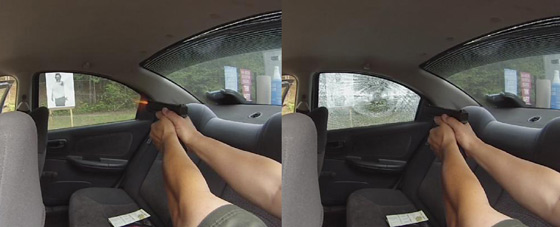 Tinted rear window just prior to (left) and after bullet strike. Polarizing effect of camera lens allows better view of target than was apparent to the shooter. Fire coming out of barrel has not been digitally altered.
Tinted rear window just prior to (left) and after bullet strike. Polarizing effect of camera lens allows better view of target than was apparent to the shooter. Fire coming out of barrel has not been digitally altered.
If the tempered glass windows are covered by a tinting film, things change. The film acts to hold the small pieces of broken glass in place like interlocking puzzle pieces. The first shot fired will shatter the glass as before, but since the glass cannot fall out of place, the result is that the window becomes almost opaque, thereby obscuring your view of the target. Expect to experience some degree of deflection every time a bullet strikes the film/glass unless bullets travel through pre-existing holes. The best option is to use something to knock the glass out once it has been broken. This can be time-consuming and dangerous.
Windshields
The front windshield offers more things to consider. In most modern vehicles, the front windshield is laminated glass. It has a layer of tough plastic sandwiched between two layers of glass. When the glass breaks, it is held in place by the plastic layer. This prevents small pieces from coming loose and flying into your eyes in an accident. It also prevents the glass from breaking into those large deadly shards. What it cannot prevent is small pieces of glass – typically dust-like – from coming off the windshield.
When shooting from the front seat(s), be conscious of the windshield. Since it is clear and nearly colorless in most vehicles and you will be focused on your threat, the stress-induced tendency to push forward into the glass should be taken into consideration. If firing a semi-auto, contact with the glass can induce a malfunction. In the event the threat is directly in front of you, the steering wheel can act as a support mechanism and prevent you from accidentally pushing the weapon into the glass.
The second major variable in shooting through a windshield is the angle of the glass. A bullet in flight is heavier in the rear than in the front. When the front of the bullet strikes glass at an angle (whether the trajectory of the bullet or the position of the glass creates the angle), the part of the bullet that touched the glass slows down first and causes the rear of the bullet to begin moving around to the front. When the bullet breaks through the glass, it continues moving in that direction. In other words, shooting from the inside of a vehicle straight through the windshield, the first round typically strikes high on the target, if it hits the target at all. For many people, this is the opposite of what they think should happen.
Field Testing
Our experiments showed that the closer the plane of the glass is to 90 degrees in reference to the bullet strike, the less disturbed the bullet in flight will be. For handguns, there is one guarantee … the first round fired through an intact windshield will be greatly deformed and in some cases will not strike the target. In vehicles with steeply angled windshields, the first round fired may even deflect into the dashboard.
The target image below illustrates some of the aforementioned issues pertaining to windshields. We have done these experiments many times and, while this is only one target, it is representative of what generally happens each time. We used a Glock 21 SF firing 230-grain hollow points (both bonded and non-bonded) and 230-grain FMJ. The target was placed directly in front of the driver, at approximately eight feet from the front bumper of a Dodge Neon. The point of aim for the first four shots is the dark spot in the center chest area marked POA.
Shots 4 and 5 were fired through the windshield in areas where the glass was not broken. Shot 4 was a non-bonded HP. It fragmented and the larger fragment struck above the target’s head. Shot 5 was a full metal jacket round. The point of aim for Shot 5 was the belt loop to the left of the number 5. The round struck the target considerably high relative to the POA. It did not fragment but did appear to tumble or deform slightly.
Coming Up
In our next evolution, I hope to cover some advanced techniques and address a few issues encountered when firing from outside the vehicle. When shooting from inside your vehicle (just like anywhere else), use good fundamentals, positively orient toward the threat, and fire multiple shots.
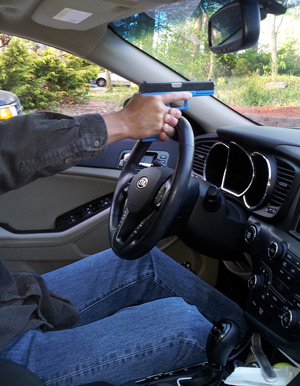
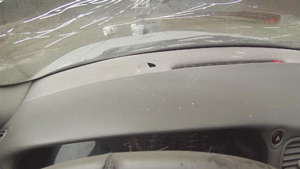
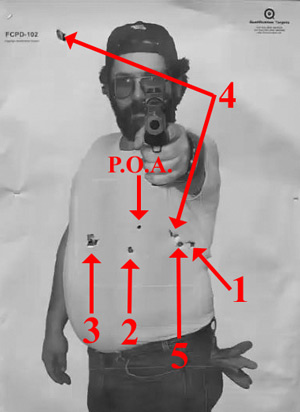


This is a real life postconviction case in which a recon marine is doing 50 years for shooting a gentleman who confused his vehicle for that of his brother. The firearm was a .45 Nighthawk with cheap .230 FMJ Federal ammo. We found that shooting from the inside/out resulted in long narrow shards (2 1/2 to 4") radiating around the impact point. The FMJ would be damaged and deflected, but the jacket would not disengage from the bullet. (NOTE: We did some proof of concept with some .38 Spec and when there was not a complete FMJ, the copper and lead would come apart quite often - although not 100%). I'm the defense counsel and the WY CL firearms expert didn't know what he was talking about. The pending motion and exhibits are available on-line (including videos of the shoots).
Good to know info based on solid demonstrations. Greatly appreciated.
Whether you reach for your gun or floor the accelerator, depends on how close the bad guy is and his position near your vehicle. If he is right next to you it probably is better to draw your gun start shooting. In most cases, shooting from afar is a bad choice mainly because you'll probably miss and lose time, giving the shooter the option of running toward you partically at the time you have to reload. I feel, in most cases, the better option is to floor the accelerator and get the hell out 0f there.
Thank you for the tutorial on inside car firing and for the examples of bullet deflection. Have seen on "Live PD" two instances of officers firing through front windshield one time, 5 shots all made separate holes in glass w/o glass shattering, perp. was taken out. thanks again! Was "on the job" in NY in 70's and 80's would not want to be out there these days! Keep the faith!
Great Information discussed. A lot of learning in on reading Thank you
Very good info thank you have you teste with 9mm 135 grain hp
On the television show Live PD, the other week a cop had to shoot through his windsheild while driving chasing a suspect and the windshield did not shatter, just the bullet holes, he used to steering wheel for support and the windshield looked almost like they look when a real big rock hits them with the exception of the bullet holes. I was impressed the windshield didn't shatter and pieces of glass fly everywhere.
Good tips. Thank you. Have more?
What if your primary eye is obstructed? Switch eyes or hands?
.